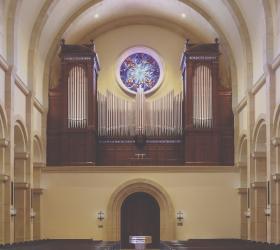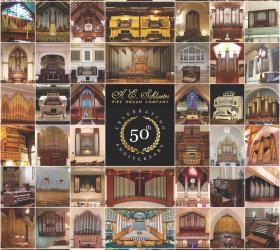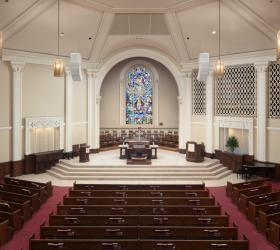
Orgues Létourneau,
St-Hyacinthe, Québec, Canada
Opus 127
St. Mark’s School of Texas,
Dallas, Texas
From the choirmaster
When I assumed my duties during the summer of 2010, discussions about a new chapel organ at St. Mark’s School of Texas had been ongoing for several years. The previous chapel instrument was originally designed and built for the school’s Collegiate Chapel, which was subsequently demolished to make room for a significant campus expansion. When relocated to the current chapel, the organ was under-scaled to the point of almost disappearing when the room was full; it was quite simply too small for the room. Further, the organ began to experience problems in the spring of 2011, with the pièce de résistance being the entire Pedal division falling silent during a chapel service.
In a meeting with then Headmaster Arnold Holtberg, he encouraged me to form an organ committee to work towards a new pipe organ for St. Mark’s chapel. I also hired David Heller, organist and chair of the music department at Trinity University in San Antonio, Texas, to serve as our consultant. Over the course of several meetings, our committee determined that our selection criteria consisted of the following:
• Ability to accompany a choral ensemble
• Ability to lead a worship service
• Performance of organ repertoire—
for worship and concert
• Proven excellence in the building
of electric-action pipe organs
• Creative designs, both visual
and tonal.
After an exhaustive search that concluded with on-campus presentations by three organbuilders, we awarded our project to Orgues Létourneau of St-Hyacinthe, Québec. We were impressed by Létourneau’s world-wide reputation for excellence in organ design and building, and also by the breadth of their instruments—the company produces not only large instruments for churches and concert halls but also small and mid-size instruments. We were gratified to see all Létourneau organs share the same high quality and attention to detail throughout.
I had the privilege of traveling to St-Hyacinthe in February 2014 to see the almost-completed instrument with Dr. Heller. I knew upon entering the Létourneau workshops that we had made an excellent choice; the quality of the materials and craftsmanship all pointed to an exciting finished product. Later that day when I entered the building where Opus 127 had been erected, I was overwhelmed with the beauty of the casework and the overall design. It has been so gratifying to hear many people remark over the past few months that the organ looks like it was designed along with the building—that it “looks like it has always been there.” This is indicative of the careful attention from concept to design to construction of the Létourneau team.
Opus 127 was delivered on September 3, 2014, and was first played in a service of Choral Evensong on November 11. Our organist, Glenn Stroh, played an extended prelude to the service, which opened with Gardiner’s Evening Hymn and concluded chorally with Mathias’s Let the People Praise Thee O God. Opus 127 did not disappoint; from the quiet opening notes of the Gardiner to the raucous conclusion of the Mathias, all in attendance were enraptured by the wide variety of color and the seamless way in which the instrument uplifted both the choir and the congregation singing. Dr. Heller played a dedication recital on January 11, 2015, in which he explored every niche of the organ’s vast tonal palette.
I am so grateful to all those involved in this project, from our fantastic committee to dedicated administrators to our donors, for giving this gift to the St. Mark’s community. This pipe organ is a gift of music that will inspire students, lead in worship, and enhance the spiritual life of St. Mark’s for many years to come.
—Tinsley E. Silcox
From the organist
The arrival of the Roosevelt Family Pipe Organ marks a significant milestone in the life of St. Mark’s School; it is the culmination of a long-held vision for an instrument designed especially to support the needs of our community.
As organist, I am excited and privileged to be able to pilot Létourneau’s Opus 127 through the many programs for which it is used at St. Mark’s, but the real value of the instrument lies in the substantial ways it has already enriched the lives of students, faculty, and guests. The installation and mere presence of an instrument like this is a wonderful and unique educational experience for our students. It is an extraordinary thing to have an organ like this in a school chapel, where some 850 young people may hear and interact with the instrument regularly. We are in the business of instilling and nurturing curiosity in our students, helping them through the course of their exploration as they learn more about themselves and the world around them. The joy of discovery, so readily seen in the faces of students as they encounter the new instrument, is rewarding and gratifying for all involved in this project.
From the beginning, the school’s reputation for excellence and its mission to provide a complete education to the young men in our charge demanded the highest possible standard. We are blessed with a fine acoustic in the chapel and space in the chapel’s rear gallery, an ideal placement for such an instrument. The organ has had an immediate positive impact in the daily life of the school, supporting vibrant music for our chapel services, school ceremonies, and fine arts programs. Given the Anglican tradition of choral singing upon which the St. Mark’s Choir was founded, the instrument was designed with the role of accompanying a choir and supporting congregational singing at the fore. Opus 127 easily facilitates expressive and dynamic accompaniment and has the ability to swell from a nearly inaudible pianissimo to the power of full organ. The English Tuba provides a particularly powerful solo voice to complete the specification. Special demonstrations of the organ have sparked interest from students and adults alike; the larger community has likewise enjoyed recitals by David Heller and James O’Donnell, organist and master of the choristers at Westminster Abbey.
I am immensely thankful for the support of the campus community, the generosity and commitment of donors, the many hours given by the organ committee, the excellent work from various members of St. Mark’s staff in preparing the chapel for the organ, and the fine craftsmanship and skill of the many Létourneau employees involved with this organ. This instrument will inspire many generations of future Marksmen, and I applaud the vision and dedication by all involved in this process.
—Glenn Stroh
From the builder
The muse for the organ at St. Mark’s School of Texas was encountered on a 2012 study trip to England. We saw many instruments on this trip, but a visit to St. Dominic’s Priory in North London stands out as having destroyed some preconceived ideas about British organbuilding. Completed in 1883, the organ at St. Dominic’s is a “Father” Willis and it stands today in largely unaltered condition. Upon arriving in the church, the titular organist, Martin Stacey, cannily introduced us to the Willis with the opening Allegro movement from Widor’s Sixth Symphony. The organ’s vigor and polish were on display from the opening chords; the effect was astonishing. Here is why Father Willis’ organs were controversial in their day: the sound is dazzling—even sensual—and like nothing else.
Within a year of this trip to England, we were contacted by St. Mark’s School of Texas and asked if we would put forward a proposal for a new pipe organ for their chapel. St. Mark’s School is renowned as one of the finest boy’s schools in the United States. Their chapel services have long been anchored by the school’s boy choirs and this choral tradition continues to the present day. When pondering what type of instrument would best serve St. Mark’s School, our thoughts turned to English boy choirs and the fine organs whose sounds are synonymous with soaring boy trebles. Though the St. Mark’s School organ would be larger, the Willis at St. Dominic’s Priory came to mind as a source of inspiration with some deference to the organ’s raison d’être of accompanying young vocal ensembles. After our presentation in July 2012, the school’s organ committee enthusiastically endorsed our vision and an agreement was concluded a few months later for the construction of a new 61-rank pipe organ.
A range of 8′ foundation stops throughout the specification permits deceptively smooth shifts in color and intensity. The large, elegant Great 8′ Open Diapason gives way to the milder Swell 8′ Open Diapason, while the Choir 8′ Geigen Diapason is yet another dynamic notch softer and has tapered pipes for a different timbre. The Great 8′ Salicional is a broad string rank with sufficient presence to color the other foundation ranks, including the treble-ascendant 8′ Harmonic Flute. The Swell division has a 16′ Contra Gamba stop with Haskell tubes to save space while preserving prompt speech; the corresponding 8′ Gamba and 8′ Voix Celeste are typically keen. The Choir 8′ Dulciana and 8′ Unda maris ranks offer a neutral string tone, with the Dulciana blending chameleon-like with other mezzo piano stops. The organ’s softest stop is the otherworldly 8′ Flute Celeste.
The influence of Willis is seen in the organ’s plenums with the inclusion of tierce ranks as well as modestly scaled upperwork with narrow mouths. Reed stops feature tapered shallots with triangular openings exclusively; chorus reeds are on higher wind pressures than the flue stops for additional power. The 8′ Vox Humana was specifically modeled after an example by Father Willis with slotted cylindrical resonators, while the 8′ Tuba sounds on 12 inches wind pressure and features hooded resonators made entirely from spotted metal. The Tuba speaks effortlessly down the chapel from its perch directly behind the Choir expression shades.
The Pedal division is robust and is undergirded by a generous 32′ Bourdon and a 32′ Contra Trombone with half-length resonators in wood. The complete principal chorus is capped by a three-rank Mixture that includes a 31⁄5′ rank giving a distinctive growl to pedal lines in counterpoint. All manual 16′ stops have been borrowed to the pedals for additional flexibility when accompanying.
The organ’s internal layout is straightforward and spacious. The two expressive divisions are stacked behind the center of the oak case with the Swell below and the Choir above. On either side of the expression boxes, the Great is divided into C and C# chests on the upper level with the Pedal likewise split below. The organ’s 16′ façade displays polished tin pipes from the Great and Pedal principals. The organ is played from a compact three-manual console that includes 256 levels of memory with 16 general pistons and a general piston sequencer (or stepper), a Great-Choir manual transfer, an All Swells to Swell function, independent combinations for the Pedal stops optionally operating from the Great or Swell divisional pistons, and a record-playback system.
When told we had been chosen to build a pipe organ for St. Mark’s School of Texas, we were honored to know the Létourneau name would be associated with such a dynamic institution. Throughout the months that followed, it was never anything short of a pleasure to work with everyone we encountered to a person. Further, the enthusiasm shown by the staff and especially the students towards the Roosevelt Family Pipe Organ has been most gratifying and encouraging. We are grateful for having had this opportunity and trust this instrument will serve the school and its worship faithfully.
—Andrew Forrest, Artistic Director
—Fernand Létourneau, President




